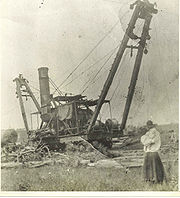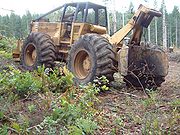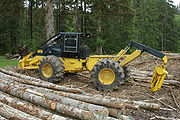
Skidder
Encyclopedia

Logging
Logging is the cutting, skidding, on-site processing, and loading of trees or logs onto trucks.In forestry, the term logging is sometimes used in a narrow sense concerning the logistics of moving wood from the stump to somewhere outside the forest, usually a sawmill or a lumber yard...
operation for pulling cut trees
Timber
Timber may refer to:* Timber, a term common in the United Kingdom and Australia for wood materials * Timber, Oregon, an unincorporated community in the U.S...
out of a forest in a process called "skidding", in which the logs are transported from the cutting site to a landing. Here they are loaded onto trucks (or in times past, railroad cars or flumes), and sent to the mill. One exception is that in the early days of logging, when distances to the timberline from the mill were shorter, the landing stage was omitted altogether, and the "skidder" would have been used as the main road vehicle, in place of the trucks, railroad, or flume. Modern forms of skidders can pull trees with a cable
Cable
A cable is two or more wires running side by side and bonded, twisted or braided together to form a single assembly. In mechanics cables, otherwise known as wire ropes, are used for lifting, hauling and towing or conveying force through tension. In electrical engineering cables are used to carry...
/winch
Winch
A winch is a mechanical device that is used to pull in or let out or otherwise adjust the "tension" of a rope or wire rope . In its simplest form it consists of a spool and attached hand crank. In larger forms, winches stand at the heart of machines as diverse as tow trucks, steam shovels and...
, just like the old steam donkey
Steam donkey
Steam donkey, or donkey engine is the common nickname for a steam-powered winch, or logging engine widely used in past logging operations, though not limited to logging...
s, or a grapple
Grapple (tool)
A grapple is a hook or claw used to catch or hold something. A ship's anchor is a type of grapple, especially the "grapnel" anchor.A throwing grapple is a multi-pronged hook that is tied to a rope and thrown to catch a grip, as on a parapet or branch of a tree...
or a clam-bunk.
History

Horse
The horse is one of two extant subspecies of Equus ferus, or the wild horse. It is a single-hooved mammal belonging to the taxonomic family Equidae. The horse has evolved over the past 45 to 55 million years from a small multi-toed creature into the large, single-toed animal of today...
s or mule
Mule
A mule is the offspring of a male donkey and a female horse. Horses and donkeys are different species, with different numbers of chromosomes. Of the two F1 hybrids between these two species, a mule is easier to obtain than a hinny...
s. The driver would straddle the cart over felled logs, where dangling tongs would be positioned to raise the end of the log off the ground. The team pulled the tongue forward, allowing the log to "skid" along between the rolling wheels. These were known as "slip-tongue wheels" Starting in the early 1920s, animals were gradually replaced by gasoline
Gasoline
Gasoline , or petrol , is a toxic, translucent, petroleum-derived liquid that is primarily used as a fuel in internal combustion engines. It consists mostly of organic compounds obtained by the fractional distillation of petroleum, enhanced with a variety of additives. Some gasolines also contain...
-powered crawlers, although some small operations continue to use them. In other places, steel "arches" were used behind the crawlers. Similar in function to the slip-tongue wheels, arches were used to reduce friction by raising up one end of the load, which was dangled from a cable which in turn ran down the back of the arch, & was raised or lowered by the crawler's winch. Another piece similar to the arch was the "bummer", which was simply a small trailer to be towed behind a crawler, on top of which one end of the log load would rest.
The early mechanical skidders were steam powered. They traveled on railroads, known as "dummylines" and the felled trees were dragged or "skidded" to the railroad where they were later loaded onto rail cars. Some were just steam donkey
Steam donkey
Steam donkey, or donkey engine is the common nickname for a steam-powered winch, or logging engine widely used in past logging operations, though not limited to logging...
s, others were more complicated. One popular brand was the Clyde Skidder, built by Clyde Ironworks in Duluth, Minnesota
Duluth, Minnesota
Duluth is a port city in the U.S. state of Minnesota and is the county seat of Saint Louis County. The fourth largest city in Minnesota, Duluth had a total population of 86,265 in the 2010 census. Duluth is also the second largest city that is located on Lake Superior after Thunder Bay, Ontario,...
. The Clyde skidder illustrated was photographed at the Marathon Lumber Company logging operations near Newton, Mississippi
Newton, Mississippi
Newton is a city in Newton County, Mississippi, United States. The population was 3,699 at the 2000 census. Country singer/songwriter Paul Overstreet was born in Newton.-Geography:Newton is located at ....
in the early 1920s. Although these machines appear to be large and cumbersome, they were true workhorses of their day. The Clyde was capable of retrieving logs from four different points at the same time. Each cable, or lead, was approximately 1000 feet in length. Once the logs were attached and a clearance signal was sent for retrieval, they could be skidded at a speed of 1000 feet per minute. Working conditions around these machines were very dangerous. The largest of these was the Lidgerwood skidder, which not only brought logs to the landing from the cutting site, but loaded them onto railroad cars as well, making it both a skidder & loader.
Modern equivalents
Contemporary skidders are trackedCaterpillar track
Continuous tracks or caterpillar tracks are a system of vehicle propulsion in which modular metal plates linked into a continuous band are driven by two or more wheels...
or four wheel drive
Four Wheel Drive
The Four Wheel Drive Auto Company, more often known as Four Wheel Drive or just FWD, was founded in 1909 in Clintonville, Wisconsin, as the Badger Four-Wheel Drive Auto Company by Otto Zachow and William Besserdich.-History:...
tractor
Tractor
A tractor is a vehicle specifically designed to deliver a high tractive effort at slow speeds, for the purposes of hauling a trailer or machinery used in agriculture or construction...
s with a turbocharged
Turbocharger
A turbocharger, or turbo , from the Greek "τύρβη" is a centrifugal compressor powered by a turbine that is driven by an engine's exhaust gases. Its benefit lies with the compressor increasing the mass of air entering the engine , thereby resulting in greater performance...
diesel engine
Diesel engine
A diesel engine is an internal combustion engine that uses the heat of compression to initiate ignition to burn the fuel, which is injected into the combustion chamber...
, winch
Winch
A winch is a mechanical device that is used to pull in or let out or otherwise adjust the "tension" of a rope or wire rope . In its simplest form it consists of a spool and attached hand crank. In larger forms, winches stand at the heart of machines as diverse as tow trucks, steam shovels and...
and steel
Steel
Steel is an alloy that consists mostly of iron and has a carbon content between 0.2% and 2.1% by weight, depending on the grade. Carbon is the most common alloying material for iron, but various other alloying elements are used, such as manganese, chromium, vanadium, and tungsten...
, funnel-shaped guards on the rear to protect the wheels. They have articulated steering and usually a small, adjustable, push-blade on the front. The operator/logger
Lumberjack
A lumberjack is a worker in the logging industry who performs the initial harvesting and transport of trees for ultimate processing into forest products. The term usually refers to a bygone era when hand tools were used in harvesting trees principally from virgin forest...
is protected from falling or flying debris (or parted cables, or rolling over) by a steel enclosure. They are one of the few logging machines that is capable of thinning or selective logging in larger timber. Forwarders can haul small short pieces out, but if mature timber is to be thinned, a skidder is one of the few options for taking out some trees while leaving others. While selective logging can be done badly in a host of ways, taking some trees while leaving some may be a preferred alternative to taking all the trees.
The skidder can also be used for pulling tree stumps, pushing over small trees, and preliminary grading of a logging path known as a "skid road".
A positive thing about the skidder is that while wood is being yarded (pulled), tree particles and seeds are cultivated into the soil.
One disadvantage of skidder logging in thinning operations is the damage to remaining trees as branches and trunks are dragged against them, tearing away the protective bark of living trees. Another concern is the deep furrows sometimes made by skidders in the topsoil
Topsoil
Topsoil is the upper, outermost layer of soil, usually the top to . It has the highest concentration of organic matter and microorganisms and is where most of the Earth's biological soil activity occurs.-Importance:...
, especially when using tires with chains, which alter surface runoff patterns and increases the costs of forest rehabilitation and reforestation.
Cable skidders

Grapple skidders

Hydraulic machinery
Hydraulic machines are machinery and tools that use liquid fluid power to do simple work. Heavy equipment is a common example.In this type of machine, hydraulic fluid is transmitted throughout the machine to various hydraulic motors and hydraulic cylinders and which becomes pressurised according to...
grapple
Grapple (tool)
A grapple is a hook or claw used to catch or hold something. A ship's anchor is a type of grapple, especially the "grapnel" anchor.A throwing grapple is a multi-pronged hook that is tied to a rope and thrown to catch a grip, as on a parapet or branch of a tree...
bucket instead of a winch, and the bucket- attached to the skidder by a boom- grabs and lifts the timber.
There are three types of 'fixed boom' grapple skidders: a single function boom type with two hydraulic cylinders, only allowing the boom to lower in one position. The dual function booms, (such as the one pictured) which has four cylinders, which allows for adjusting the boom in two different places. The third type that permits the grapple boom to be swung from side to side allowing spread out trees to be grabbed at once.
In some areas, loggers have combined a hydraulic claw on the side the blade of their grapple skidders, making it possible to pile logs in some cases.(More commonly seen on cable skidders) This also permits hauling back bark and tops when returning from a "landing" to a cut block.

